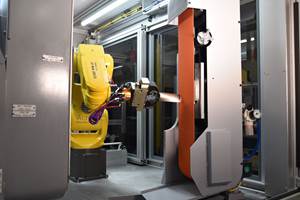Castor Publishes Sustainability in Additive Manufacturing Trends Report
New research from Castor indicates manufacturers can reduce tons of carbon emissions with 3D printing.
The research for Castor’s sustainability report is based on Castor’s software calculator, which reveals the amount of CO2 emissions that can potentially be saved by using AM instead of traditional manufacturing. Photo Credit: Castor
Castor, an industrial 3D printing software company, has released new research that indicates manufacturers can reduce carbon emissions through additive manufacturing (AM), showing that more than one-third of 3D printed parts can reduce carbon emissions.
The research is based on Castor’s latest addition to its software, a calculator that reveals the amount of CO2 emissions that can potentially be saved by using AM instead of traditional manufacturing.
The report emphasizes the environmental benefits of using AM over traditional manufacturing methods. It highlights different aspects where AM has strong CO2 emissions-saving potential as in complex geometries parts and spare parts that be produced on demand.
As an example, the report illustrates how the avoidance of the production and disposal of a single spare part over a 10-year period can lead to a significant reduction of 3 tons of CO2 emissions — which is equivalent to the emissions produced by 18,000 kilometers traveled in a diesel automobile or 216 train trips between Paris and Amsterdam. The company says these findings demonstrate the potential for AM to make a significant impact on a company's carbon footprint.
“Business leaders are under increasing pressure to reduce carbon emissions — from stakeholders, customers and from regulatory bodies. Companies must explore new innovative manufacturing processes if they are to become more environmentally-friendly,” says Omer Blaier, Castor’s co-founder and CEO. “We believe that the contribution of Additive Manufacturing to sustainability is growing, and we are committed to developing methods to reflect its benefits.”
Castor’s software enables manufacturers to automatically analyze their parts and determine whether production with AM makes sense — from a technical, economical and now also sustainable point of view.
As stated in the report, Castor’s Carbon Emissions calculator is derived by analyzing parts through their various stages life cycle. The calculator’s considerations are aggregated from factors such as material production, product manufacturing, product use, transportation and part end-of-life.
The report is based on the data of more than 50,000 assemblies and parts that have been uploaded to Castor’s software over the past three years. The company gathered all the interesting trends that were identified and created a report that summarizes insights into AM as a sustainable way of production.
The company says this innovation provides companies with valuable information and transparent sustainability reporting on their parts’ CO2 emission, enabling them to drive more informed and sustainable decisions across the organization.
The report is available for free download.
• Learn how Castor’s software can automatically identifies suitable parts for 3D printing using 2d drawings.
• Read about the integration of Castor’s part screening software into Ultimaker’s Digital Factory, enabling users to scan all of their parts at once, estimate the printability of parts with their Ultimaker printer, calculate the costs and lead time, and ultimately produce the parts directly with Ultimaker’s Digital Factory.
Related Content
3D Printed Cutting Tool for Large Transmission Part: The Cool Parts Show Bonus
A boring tool that was once 30 kg challenged the performance of the machining center using it. The replacement tool is 11.5 kg, and more efficient as well, thanks to generative design.
Read More3D Printed "Evolved Structures" for NASA Exoplanet Balloon Mission: The Cool Parts Show #61
Generative design creates stiff, lightweight brackets for EXCITE mission monitoring planets orbiting other stars. The Cool Parts Show visits Goddard Space Flight Center.
Read MoreAircraft Engine MRO: How Additive Manufacturing Plus Robotic Finishing Will Expand Capacity for Blade Repair
AM offers the chance to bring fast, automated processing to individualized, part-by-part restoration of turbomachinery. A cell developed by Acme Manufacturing and Optomec is able to automatically repair 85,000 unique aircraft engine blades per year.
Read MoreActivArmor Casts and Splints Are Shifting to Point-of-Care 3D Printing
ActivArmor offers individualized, 3D printed casts and splints for various diagnoses. The company is in the process of shifting to point-of-care printing and aims to promote positive healing outcomes and improved hygienics with customized support devices.
Read MoreRead Next
To Improve Performance of Compression Molded Composites, Add 3D Printed Preforms
9T Labs' Additive Fusion Technology enables the manufacture of composite structures with as much or as little reinforcement as is necessary, using 3D printed continuous fiber preforms to add strength just where needed.
Read MoreVideo: Intelligent Layering Metal 3D Printing at 3DEO
Contract manufacturer 3DEO delivers metal parts using Intelligent Layering, a binder jetting-like 3D printing process the company developed and operates internally. Here’s how it works.
Read More3D Printing Brings Sustainability, Accessibility to Glass Manufacturing
Australian startup Maple Glass Printing has developed a process for extruding glass into artwork, lab implements and architectural elements. Along the way, the company has also found more efficient ways of recycling this material.
Read More














.png;maxWidth=300;quality=90)









